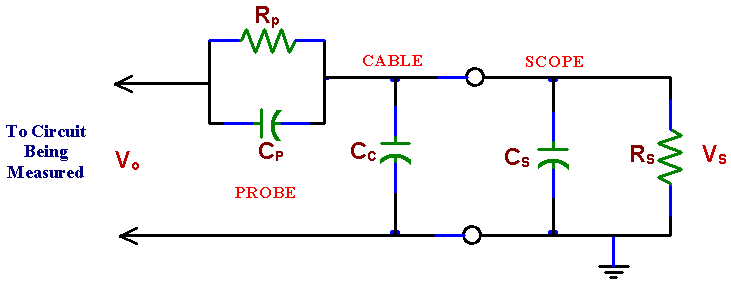|
ECE291 - LABORATORY VII INPUT IMPEDANCE OF AN OSCILLOSCOPE AND THE SCOPE PROBE
OBJECTIVES Measurement of the oscilloscope input impedance. Principles of operation and usage of the scope probe.
INTRODUCTION After becoming familiar with the frequency response of RC circuits in the previous laboratory, you are ready to learn about the oscilloscope input impedance. This complex impedance, which has resistive and capacitive components, can disturb performance of circuits being measured and limits high frequency performance of oscilloscopes. Fortunately there is a remedy, which you should know about: the scope probe. A scope probe is essentially a 10:1 attenuator with a resistor and a capacitor at the end of the probe cable. The attenuator consists of two impedances in series, one of which is the scope’s own impedance to ground while the other is attached between the point of measurement in a circuit and the scope input. For only dc measurements we could use a resistor as the external impedance. The same would be true also for ac measurements if the scope internal impedance was only resistive. The scope internal impedance, however, has a capacitive component. Note that the capacitance of the scope cable adds to the internal capacitance of the scope input. This not only makes it much larger but also dependent on the length of the cable used. Very bad for high frequency measurements! To make things worse, the load that the scope with its cable presents to a measured circuit depends on frequency and amplitude measurements with the scope are frequency dependent. The scope probe solves this problem not by eliminating this capacitance (which is not possible) but by compensating it with another capacitance. The probe capacitance is chosen so that the measurement is independent of frequency. If the probe impedance is not matched properly to the scope internal impedance the attenuation depends on frequency and thus acts as a filter. Fortunately there is an easy way to adjust the probe impedance with a built-in small trimming capacitor. A filter distorts a square wave so the trimming capacitor can be adjusted by observing a distortion of a square wave on the scope screen. Oscilloscopes are equipped with internal square wave generators for easy probe adjustments. The probe test terminal is provided on the front panel. The probe capacitor is adjusted until there is no distortion of the square wave. A scope probe is a very handy device used by professionals all the time. From now on you should use it too!
|



